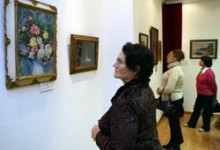Excavations were recently completed in one of the oldest districts of Kyiv, Podil, on Spaska vul., 35. Archeologists say their primary mission is to find and preserve historical treasures before construction works start in this area. In two years of research they have found many interesting items here. One of the most recent findings are pieces used in the Old Rus’ game of tavli, which resembles modern chess. They are made of walrus tusks, which were brought to Kyivan Rus’ from the Scandinavian countries.
“Tavli is an ancient game of the Old Rus’ period,” sats Natalia Khamaiko, who supervises the excavations on Spaska street. “It is difficult to say exactly where these pieces were made in Kyivan Rus’, but they are a mirror image of the toys found in Scandinavia. We presume that they were made by Scandinavians who had come to Rus’, because a tusk is very hard to process: it does not have any dentine, just enamel, which makes it difficult to cut, and one should know well how to do this. Therefore, it is most likely that Scandinavians did this,because this art was unknown to Ruthenians.”
So far archeologists have found four tavli pieces from different sets. No one knows how many figures a full set contains. What is known, however, is how to play tavli: the king piece guarded by his camp is placed on the board lined in squares or some other geometrical pattern. As Khamaiko explained, opponents stand in the board’s four corners; the king piece wins if it reaches a corner and loses if surrounded from four sides.
Kyivites and the guests of the city will soon be able to see the tavli pieces in the museum of the Kyiv Archeology Center. Tavli will be transferred here after they are processed and examined by specialists. In addition to these pieces, scholars found fragments of walrus sculls, which served as material to make these toys from.
“The tavli pieces make a significant contribution to the study of Kyiv’s history,” Khamaiko adds. “Since the excavation area is a former private estate, the findings indicate that the hosts had trade relations with Scandinavians, which was no longer typical of the 12th century, but now the proof is before our eyes, so to say. The excavated toys indicate that the residents of this area were not average people because they could pay for expensive goods made from walrus tusks. All this is proof of Kyiv’s development and its connections with other countries; it also informs us about the financial situation of the people who lived in this area.”
Archeologists have gathered an entire collection of findings during the excavations. Until recently a 12th-century sword was considered to be one of the most unique items. It was found in the building that burned down when Kyiv was being sacked by Andrei Bogoliubski. Now tavli are the number one finding. Other Old Rus’ games were found at the site-draughts and knucklebones (resembling children’s game of dibs in which a player had to knock down other players’ figures with his/her dib).
Scholars argue that games were quite a popular pastime in Kyivan Rus’. Soldiers would play them most frequently, and kings were great lovers of games. In Medieval Europe there were even codes of laws that provided for a number of limitations for warriors. For example, they could not play for their horses or gear: a war could start the next day and they would have no combat gear. Interestingly, there was time when the skill in playing board games was equated to heroism at war.







